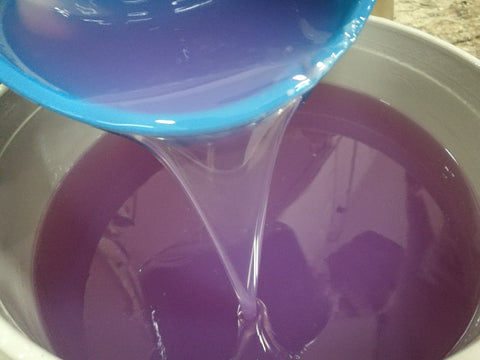You have no items in your shopping cart.
Fiberglass and resin are two popular materials used by boat builders, car restorers and other fiberglass enthusiasts. It's often used in hobby and DIY projects because it's relatively inexpensive and easy to work with. However, there are a few common mistakes that people make when working with fiberglass and resin. In this blog post, we'll talk about 7 common mistakes and how to avoid them.
1. Mixing too Much Resin at one Time

It’s important not to mix too much resin at once. You want to make sure you take the time to apply the resin in small batches. If you rush and make one large batch, the resin may get extremely hot and may even start smoking. This is called exo-therming. It can kick off in the mixing container before you have a chance to use it. Be aware that the room temperature will also influence how fast resin will begin to harden.
Allow enough time for your project. The time needed will depend on how big the project is and could vary from several hours to several days. This is because you need to allow for curing time between layers or pours. Follow the manufacturer’s pouring/mixing instructions for your product so you have a successful project.
2. Not Using Enough Resin

Using too little resin with fiberglass can also be a problem. If you don’t use enough resin, the fiberglass may not stick to the surface properly. It can also lead to fiberglass fibers fraying and your final product could be brittle and weak.
Make sure to prep your surface by doing a coat or two of resin on the substrate first. This is especially important if you are working with a surface such as wood or balsa core. These surfaces will absorb a lot of resin. If you coat the surface first and let it cure, your laminate will not lose much, if any, resin and it will create a better bond.
On the flip side, you don’t want to use too much resin. You can use a roller or spreader to get rid of any excess resin you notice when laminating.
3. Adding too Much or too Little Hardener

If you add too much hardener to your resin, it will cure too quickly and will be very difficult to work with. On the other hand, if you don't add enough hardener, the curing process will take much longer than usual if it cures at all.
The room temperature will be a factor in the curing process as well. You may need to adjust the amount of hardener if you are working with polyester or vinyl ester resin (slightly more for cold weather and slightly less for hot weather). **It is important to note that you cannot vary the hardener amount when working with epoxy resin. Epoxy requires exact amounts of resin with hardener or else it will not cure correctly. **
If you are not sure how much hardener to add to your polyester or vinyl ester resin, you can check out our MEKP catalyst chart here- https://fiberglasswarehouse.com/pages/mekp-catalyst-quantity-chart . If you are working with epoxy, it is typically measured as a 1:1, 2:1, 4:1 or 5:1 ratio by volume or weight depending on manufacturer. Make sure to follow the instructions on the bottle for exact measuring instructions.
Adding Chopped Strand Mat Unevenly

When applying chopped strand mat, make sure that you apply it evenly across the surface. If you apply the fibers too thick in some areas and not enough in others, you may end up with weak spots or fiberglass-heavy spots. When you add the polyester or vinyl ester resin to the mat, the styrene binder will dissolve allowing you to move the fibers around. You can use a spreader or roller to not only work the resin into the mat but also to make sure you have a nice even amount of fiberglass and resin over the entire work area.
**Epoxy resin is not compatible with chopped strand mat.
Not Mixing Resin Thoroughly

It's important to mix the resin thoroughly in order to avoid any soft uncured spots in your project. Use a tongue depressor or stir stick to mix. Make sure to scrape down the sides of the mixing cup as you stir it so the resin and hardener are mixed evenly. It is especially important to mix well when working with epoxy resin.
Using the Wrong Resin

When working with chopped strand mat (CSM), you need to use a polyester or vinyl ester resin rather than an epoxy resin. Epoxy resins will not bond properly with most chopped strand mat and will result in a weaker final product. This is because chopped strand mat is made up of short fiberglass strands held together by a styrene binder. This binder needs the styrene in polyester or vinyl ester resins to dissolve in order for the mat to become pliable.
When doing a repair, you should find out what resin was originally used. If the part was made with polyester resin, you can use epoxy resin over top. Epoxy resin will adhere to polyester resin surfaces. The opposite is not true. If a part was made with epoxy resin and you use polyester resin, the polyester will not adhere well. If you are making a part and are planning to gel coat it, make sure you use polyester because gel coats are typically colored polyester resins. This will ensure your gel coat bonds well to the part.
Not Working in a Well-ventilated Area

Resin fumes can be harmful if inhaled for extended periods of time without proper ventilation. Always work in a well-ventilated area such as outdoors or in a garage with the door open when using fiberglass and resin so that harmful fumes are not concentrated in one area. You could also open a window to allow fresh air to circulate.
It is also important to wear a respirator mask and use the proper safety clothing to avoid getting resin in your eyes, nose or on your skin. If you skip this part and do not wear the proper safety equipment, you could end up inhaling toxic fumes, burning your skin or ruining clothing. Use a respirator, safety goggles and gloves. You could also get a spray sock and Tyvek coveralls if you want to further protect yourself.
Conclusion
When working with fiberglass and resin, it is important to take care and avoid making common mistakes. By following these tips, you can ensure that your project turns out safely and successfully.
For more information on fiberglass and resins, check out our Ultimate Fiberglass and Resin Guidebook for Beginners .
If you have more questions, don’t hesitate to reach out to us. You can email us at sales@fiberglasswarehouse.com or call us at 1-833-669-7899. We are always happy to help. We want your project to be a success.
comments (8)
-

-
 Joe
JoeCan I fibreglass over the polyester gelcoat if the gelcoat is good and chemically bonded to the fibreglass / polyester resin substrate? Will the fibreglass/ epoxy bond be just as good over the gelcoat instead of the substrate?
-
 Fiberglass Warehouse
Fiberglass Warehouse@William- you can use pretty much any resin with polyurethane foam. It won’t turn to goo like EPS foam. Polyester, vinyl ester, or epoxy will work.
-
 William (Bill) C. McElroy, author for Craftsman Book Company and Prentice Hall
William (Bill) C. McElroy, author for Craftsman Book Company and Prentice HallWhat can I use over GE Insulating Foam, Gaps & Cracks. I have facia that is rotted and needs to have a filler before I can put a coating of fiberglass and resin over it. Would have loved to just replace the 2 × 8 but the flat roofing is nailed to it and that becomes a major job.
-
 Fiberglass Warehouse
Fiberglass Warehouse@Matthew- The vinyl ester resin will adhere to the polyester, and not so good to the epoxy. If the boat is epoxy, you will want to use epoxy.










@Joe- Typically you want to remove all the old gelcoat if you will be adding more fiberglass. Reason being is the gel coat will be a weak spot in the laminate.